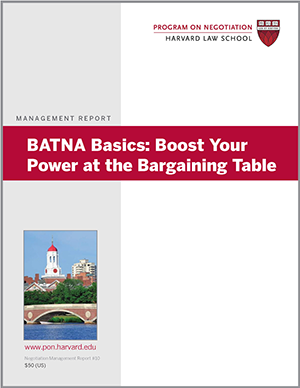
Your best alternative to a negotiated agreement (BATNA) and breaking down barriers at the bargaining table
If your current negotiation reaches an impasse, what’s your best outside option? Most seasoned negotiators understand the value of evaluating their BATNA, or best alternative to a negotiated agreement, a concept that Roger Fisher, William Ury, and Bruce Patton introduced in their seminal book, Getting to Yes: Negotiating Agreement Without Giving In (Penguin, 1991, second edition). Even those who don’t know the term probably think through their BATNA instinctively as they prepare for a negotiation.
Finding your best alternative to a negotiated agreement (BATNA)
An awareness of your BATNA—particularly if it’s a strong one—can give you the confidence you need to walk away from a subpar agreement. Here are two strategies to help you take the BATNA concept to the next level and gain a critical advantage in upcoming deals.
Translate your BATNA to the current deal
Here’s a classic example of BATNA: while haggling over a rug in a bazaar, you’re aware that you can purchase an identical rug at a nearby stall for $100. Assuming that you want only one rug, you won’t pay more than $100 in the negotiation at hand.
Unfortunately, such clear-cut BATNAs tend to exist more in theory than in reality. In truth, your best alternative to agreement is rarely, if ever, apples-to-apples comparable with the deal at hand.
The implication? When negotiating, take time out for an explicit translation process to ensure that you aren’t giving up a good deal in hand for a BATNA in the bush.
For example, as the renewal deadline for his homeowner’s insurance policy approached, Larry decided to do a “market check” to compare prices. His existing insurer—let’s call it Acme—had been raising its rates by 7% to 10% annually for the past three years, and Larry wasn’t sure he was getting the best deal. He then found a carrier that offered a policy for 30% less than Acme’s renewal rate.
Delighted, Larry came very close to switching to the new insurer. But after doing some digging (and receiving some self-interested guidance from Acme), Larry identified important coverages and term definitions buried deep in the legalese of the two policies. After going through a translation process to make the prices comparable, Larry realized that Acme, his current insurer, was offering him a better deal.
The lesson: Rather than assuming that the deal on the table matches your BATNA point by point, translate your BATNA to fully understand what it means for the current negotiation.
What is WATNA?
Negotiators often complain that their best alternative away from the table is rarely a sure thing. As a consequence, some focus instead on their worst alternative to a negotiated agreement (WATNA).
A wise strategy? Probably not. Imagine that you’re a procurement manager trying to renegotiate a contract with a supplier, for instance. If talks reach an impasse, the worst thing that could happen is that you won’t find an alternative supplier, and your supply chain will temporarily break down. If you negotiate on this basis, you will almost certainly get a bad deal. And if your odds of not finding an alternative supplier are only 5%, it would be silly to negotiate on the basis of your WATNA.
Instead, try to calculate your probabilistic BATNA—the full range of possibilities if the negotiation fails and the probabilities associated with each.
Decision-tree analysis, which lawyers often use to assess the BATNA of going to court if settlement talks fail, can be just as helpful in the business world. Making a decision tree involves graphing the possible outcomes of each decision you are facing.
Decision-tree analysis has three benefits. First, it illuminates aspects of your BATNA that you can—and should—shore up before you negotiate. When facing talks with an existing supplier, identifying another ready supplier of the product under discussion beforehand would eliminate concerns about your WATNA and might even transform your BATNA into a sure thing.
Second, decision trees help you assess your risk tolerance. Would you prefer a sure thing at the table to a chance at a better outside option? Start with a risk-neutral assessment of your BATNA, and then adjust your willingness to close the current deal based on the fact that your BATNA is not a sure thing.
For example, in a recent high-stakes real-estate negotiation, an adviser asked the bidder’s principal decision maker, “How would you feel about a deal at $240 million today compared to a 90% chance for a deal at $200 million in six months?” The bidder—who clearly did not like the risk inherent in her probabilistic BATNA—jumped at the chance to pay $240 million with certainty.
Finally, when you are assessing your BATNA, decision trees facilitate the familiar negotiation advice “Look forward and reason back.” At each node in the tree, ask yourself “And then what?” Even if you cannot attach probabilities all the way down the tree, you’ll gain a better understanding of possible moves and countermoves.
Has a BATNA helped you in negotiation? Share your experiences in the comments below.
Adapted from the article “Taking BATNA to the Next Level” by Harvard Law School and Harvard Business School professor Guhan Subramanian, first published in the Negotiation Briefings newsletter.




